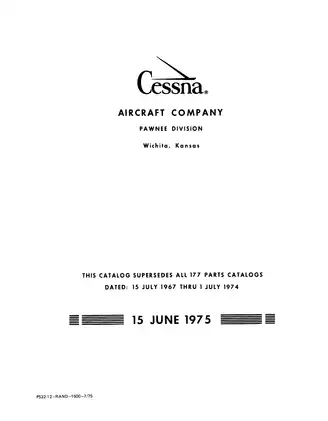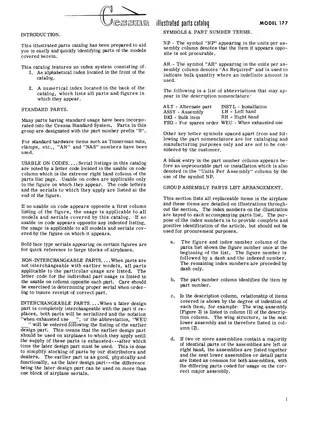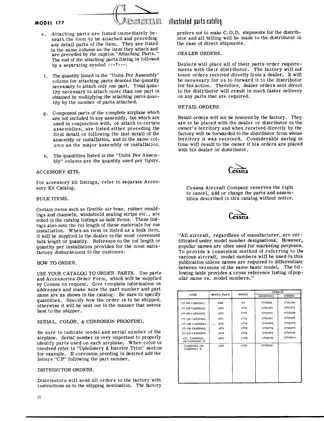Cessna Model 177 Illustrated Parts Catalog and Parts Lookup - 1968 to 1975
Product Gallery

Sample pages from the Cessna Model 177 Illustrated Parts Catalog and Parts Lookup - 1968 to 1975 manual



Purchase Information
1968-1975 Cessna 177, 177A, 177B, Cardinal II - Illustrated Parts Catalog - Technical Specifications
- Document Number / Seller:
- 28160 / Daniel Grant
- File Size:
- 26.30 MB
- File Type:
- Language:
- English
- Pages:
- 375
- Printable:
- Yes
- Estimated Download Time:
- 0.54 Minutes
- Delivery Format:
- Digital (PDF) - Instant Access
- Category:
- Aircraft
- Brand:
- Cessna
- Reviewed and Approved:
- Apr 5, 2025
Cessna Models and Parts Covered in this Aircraft Manual
- Cessna 177 (1968)
- Cessna 177A (1969)
- Cessna 177B (1970)
- Cessna 177B (1971)
- Cessna 177B (1972)
- Cessna 177B (1973)
- Cessna 177B (1974)
- Cessna 177 Cardinal II (1975)
Complete Manual Information
Cessna Model 177 Illustrated Parts Catalog
This comprehensive Illustrated Parts Catalog for the Cessna Model 177 serves as an essential reference for identifying and ordering parts for various configurations of this aircraft model. Covering production years 1968 to 1975, this manual includes detailed illustrations and specific part numbers, making it easier for maintenance personnel to find the required components efficiently.
What's Inside
The catalog features a systematic layout, allowing users to navigate through sections easily. Key inclusions are:
- Tables of Contents listing all parts
- Index pages categorizing parts both alphabetically and numerically
- Detailed illustrations corresponding with part numbers for quick reference
- Instructions for ordering parts based on serial numbers and part identification codes.
Whether you are a technician needing quick access to parts for repair or an aircraft owner seeking maintenance documentation, this Cessna Model 177 Illustrated Parts Catalog is an invaluable resource.
Key Features:
- Extensive index for part numbers and descriptions for efficacy.
- High-quality illustrations aiding in the identification of parts by visual reference.
- Specifics on paint colors and interior finishes ensuring accurate restorations.
Stay prepared and informed with this essential guide that simplifies aircraft maintenance and parts procurement
Download Instructions for Cessna Aircraft Manual
Frequently Asked Questions - Cessna Aircraft Manual
What does this Cessna manual cover?
This comprehensive service manual covers detailed repair procedures, maintenance schedules, troubleshooting guides, and technical specifications for Cessna Model 177 Illustrated Parts Catalog and Parts Lookup - 1968 to 1975. It includes information for the following models: - Cessna 177 (1968) - Cessna 177A (1969) - Cessna 177B (1970) - Cessna 177B (1971) - Cessna 177B (1972) - Cessna 177B (1973) - Cessna 177B (1974) - Cessna 177 Cardinal II (1975).
Is this manual suitable for beginners?
Yes, this Cessna manual is designed for both professional technicians and DIY enthusiasts. It includes step-by-step procedures with clear illustrations and safety guidelines for Aircraft maintenance and repair.
What file format will I receive?
You will receive this manual as a PDF file (26.30 MB), which is compatible with all devices. The manual is fully searchable and printable for your convenience.
How quickly can I access the manual after purchase?
You'll receive instant access to your Cessna Aircraft manual immediately after payment completion. The download link is valid for 3 days, with lifetime re-download guarantee.
Can I print specific sections of the manual?
Absolutely! This digital manual allows you to print any section you need, from individual pages to complete chapters, making it perfect for workshop use.
Customer Reviews and Feedback
Read what our customers say about this Cessna Aircraft manual and share your own experience.
Add Comment
This policy contains information about your privacy. By posting, you are declaring that you understand this policy:
- Your name, rating, website address, town, country, state and comment will be publicly displayed if entered.
- Aside from the data entered into these form fields, other stored data about your comment will include:
- Your IP address (not displayed)
- The time/date of your submission (displayed)
- Your email address will not be shared. It is collected for only two reasons:
- Administrative purposes, should a need to contact you arise.
- To inform you of new comments, should you subscribe to receive notifications.
- A cookie may be set on your computer. This is used to remember your inputs. It will expire by itself.
This policy is subject to change at any time and without notice.
These terms and conditions contain rules about posting comments. By submitting a comment, you are declaring that you agree with these rules:
- Although the administrator will attempt to moderate comments, it is impossible for every comment to have been moderated at any given time.
- You acknowledge that all comments express the views and opinions of the original author and not those of the administrator.
- You agree not to post any material which is knowingly false, obscene, hateful, threatening, harassing or invasive of a person's privacy.
- The administrator has the right to edit, move or remove any comment for any reason and without notice.
Failure to comply with these rules may result in being banned from submitting further comments.
These terms and conditions are subject to change at any time and without notice.
Comments (3)